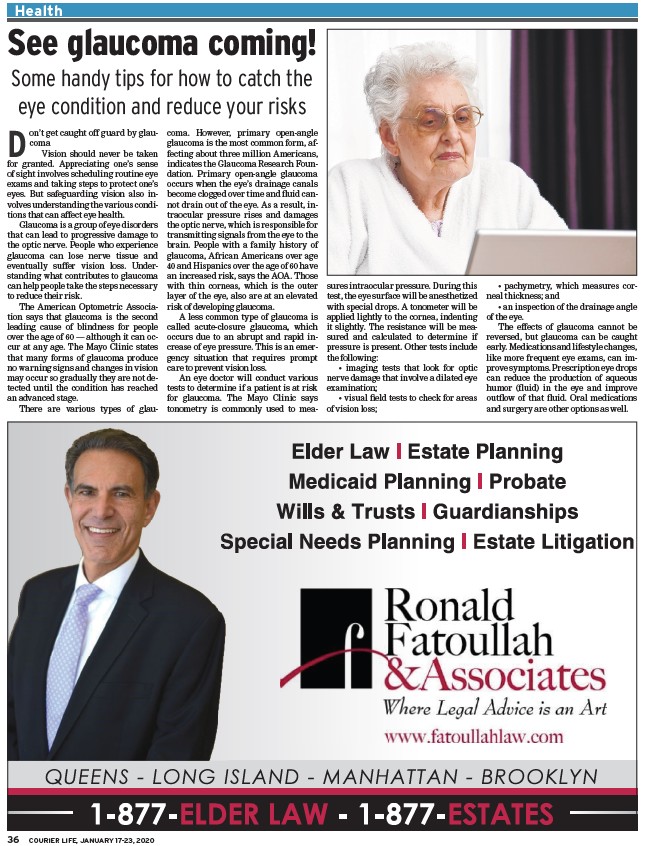
Health
Don’t get caught off guard by glaucoma
Vision should never be taken
for granted. Appreciating one’s sense
of sight involves scheduling routine eye
exams and taking steps to protect one’s
eyes. But safeguarding vision also involves
understanding the various conditions
that can affect eye health.
Glaucoma is a group of eye disorders
that can lead to progressive damage to
the optic nerve. People who experience
glaucoma can lose nerve tissue and
eventually suffer vision loss. Understanding
what contributes to glaucoma
can help people take the steps necessary
to reduce their risk.
The American Optometric Association
says that glaucoma is the second
leading cause of blindness for people
over the age of 60 — although it can occur
at any age. The Mayo Clinic states
that many forms of glaucoma produce
no warning signs and changes in vision
may occur so gradually they are not detected
until the condition has reached
an advanced stage.
There are various types of glaucoma.
COURIER L 36 IFE, JANUARY 17-23, 2020
However, primary open-angle
glaucoma is the most common form, affecting
about three million Americans,
indicates the Glaucoma Research Foundation.
Primary open-angle glaucoma
occurs when the eye’s drainage canals
become clogged over time and fl uid cannot
drain out of the eye. As a result, intraocular
pressure rises and damages
the optic nerve, which is responsible for
transmitting signals from the eye to the
brain. People with a family history of
glaucoma, African Americans over age
40 and Hispanics over the age of 60 have
an increased risk, says the AOA. Those
with thin corneas, which is the outer
layer of the eye, also are at an elevated
risk of developing glaucoma.
A less common type of glaucoma is
called acute-closure glaucoma, which
occurs due to an abrupt and rapid increase
of eye pressure. This is an emergency
situation that requires prompt
care to prevent vision loss.
An eye doctor will conduct various
tests to determine if a patient is at risk
for glaucoma. The Mayo Clinic says
tonometry is commonly used to measures
intraocular pressure. During this
test, the eye surface will be anesthetized
with special drops. A tonometer will be
applied lightly to the cornea, indenting
it slightly. The resistance will be measured
and calculated to determine if
pressure is present. Other tests include
the following:
• imaging tests that look for optic
nerve damage that involve a dilated eye
examination;
• visual fi eld tests to check for areas
of vision loss;
• pachymetry, which measures corneal
thickness; and
• an inspection of the drainage angle
of the eye.
The effects of glaucoma cannot be
reversed, but glaucoma can be caught
early. Medications and lifestyle changes,
like more frequent eye exams, can improve
symptoms. Prescription eye drops
can reduce the production of aqueous
humor (fl uid) in the eye and improve
outfl ow of that fl uid. Oral medications
and surgery are other options as well.
See glaucoma coming!
Some handy tips for how to catch the
eye condition and reduce your risks